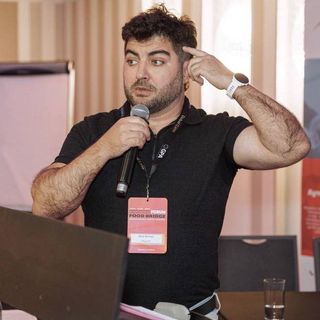

The founder of Binom AI, Vladimir Winner, shares his experience with founders and executives of businesses on integrating AI into business processes.
More and more often, the question arises:
Is it possible to create a box version to make an AI copy of experience and store it locally? I understand this desire, as preserving a company’s intelligence or your personal intelligence is becoming a new form of intellectual property.
My goal is to provide information for decision-makers in companies without delving into technological details. I want to help you understand the innovations that need to be implemented in your organization.
The essence of the box version is that the company will have an autonomous server and processor, as well as software based on a vector knowledge base. This base will contain various questions, answers, and ways to compile them (decision-making) based on accumulated experience. Currently, your Binom operates in a cloud environment.
What is the difference between the box and cloud versions?
Cloud Version:
Advantages:
– Scalability: It is easy to increase resources (servers) as needed, allowing for flexible responses to changing business needs.
– Accessibility: Data and functions are available from any device connected to the internet, simplifying the work of remote employees.
– Updates and Maintenance: All software updates and maintenance are performed automatically, reducing the need for technical support.
Disadvantages:
– Dependence on Internet Connection: A stable internet connection is required to access data and functions.
Box Version:
Advantages:
– Control Over Data: All data is stored locally, giving complete control over the information and the ability to protect it from external threats.
– Own Infrastructure: Allows for operation without the need for a constant internet connection, which can be critical for some businesses.
Disadvantages:
– High Initial Costs: The need to invest in equipment and software can be significant.
– Scaling Challenges: Increasing capacity requires additional investments and time to set up new equipment.
To create a box version, the following conditions must be considered:
– Two servers with GPUs: One primary and one backup (approximately €20,000).
– Specialized software: Including Binom itself with a vector database (around €3,000 per year).
For your neural network to learn effectively, it is essential to have a sufficient number of processed requests, including various cases and consultations. This will allow the local version to learn from relevant data. The cloud Binom significantly reduces costs, as there is no need to maintain a team to train the local version. Experience is gained in the cloud and can be gradually transferred to the local version.
We are moving towards such a solution. For the local version to make sense, it is necessary to gather at least 5,000 dialogues to maintain dynamics. Here are the three steps we are currently planning:
We also plan to develop a hybrid solution: the local version will be more efficient if it can integrate with cloud solutions while having the capability to operate autonomously.
However, the local version must constantly learn and maintain connections via API with data sources, CRM systems, and databases to remain relevant, even when operating in local mode.
A bit about the terms that are often confused. Your local neural network consists of:
– GPU (Graphics Processing Unit): The graphics processor is responsible for performing complex calculations related to graphics and machine learning. It can perform many operations simultaneously, making it ideal for tasks that require high performance, such as training neural networks. Simply put, the GPU is the “brain” of your system when it comes to processing visual information and analytics.
– CPU (Central Processing Unit): The central processor manages all the main tasks of your computer. It performs calculations, makes decisions, and coordinates the operation of all system components. Think of it as the “director” who organizes and allocates tasks among the various “workers” of your device.
– VRAM (Video RAM): Video memory is used by the graphics processor to store temporary data, such as textures and images that need to be processed quickly. It allows the GPU to work efficiently with graphics without constantly referring to the main memory, thereby improving overall performance. You can think of VRAM as the “table” for the GPU, where all the necessary tools for working with visual information are stored.
What about the costs?
Cloud Version | Local Version |
Speed of Implementation (weeks) | Speed of Implementation (months) |
Training Time (weeks) | Training Time (depends on the amount of data and the speed of processing by the team) |
Implementation Cost (from €450, current usage costs from €650 per year) | Training Time (depends on the amount of data and the speed of processing by the team) – Implementation Cost (equipment from €10,000, software installation from €3,000, software cost from €1,000 per year, team salaries for training AI from €50,000) |
I believe I’ve explained everything. If you have any questions, feel free to reach out!
Yours,
Vladimir Winner